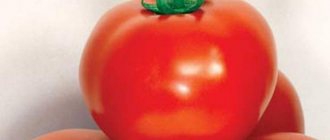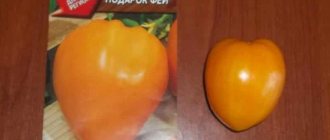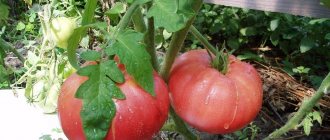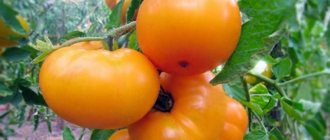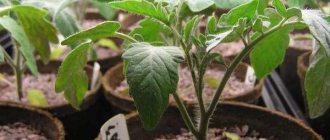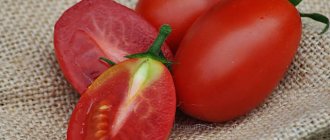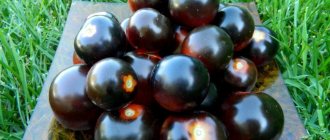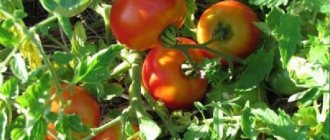A tomato is just a tomato. Nothing like this! The pink-fruited juicy Tsunami will not leave any farmer indifferent. Among its indisputable bonuses are high productivity, excellent product and taste characteristics, ease of cultivation and excellent stability.
| Height | Landing location | Ripening time | Fruit color | Fruit size | Origin | Fruit shape |
| Medium height | Greenhouse, Open ground | Mid-early | Pink | Large | Variety | Flat-round |
Characteristics and description of the variety
Bushes of the Tsunami variety can reach 60 cm in height and grow in 1-2 stems. The leaves of the plant are corrugated. During the growth process, 6-7 clusters appear, on each of which an average of five tomatoes grow.
Distinctive features
The fruits are distinguished by the following characteristics:
- weight of tomatoes - 230-250 g. Maximum - up to 300 g;
- pink colour;
- shape - flat and round, slightly ribbed;
- the pulp is very juicy, the skin is thin;
- tomatoes can be eaten fresh, used in salads and in the preparation of juices and ketchups.
Productivity
The fruits grow smooth and slightly ribbed; when they reach maturity, they acquire a crimson color. You can see examples in the photo. Great for any use: storing for the winter, cooking and eating raw.
With proper care, you can harvest 3-4 kg of tomatoes from one bush, which is considered an excellent yield indicator for this variety.
How to grow seedlings
Let's take a step-by-step look at how to properly grow Tsunami tomato seedlings.
Seed preparation
First, you need to prepare the seeds for planting and carry out preventive measures to treat them to protect against viral diseases with a disinfectant - a solution of potassium permanganate or “Fitosporin”.
Container and soil
The soil is prepared from a disinfected mixture of garden soil with compost, fertilizers and ash. It is necessary that the soil is nutritious, loose and permeable to air. The container should be shallow; it can be grown in peat pots.
Before sowing, moisten the seedling boxes and plant pre-treated seeds approximately 2-3 cm apart, covering them with a small (5-7 mm) amount of soil. Then cover and place the boxes close to heat, such as radiators.
When the first shoots begin to appear, place them on a windowsill or near a lamp with artificial lighting.
Growing and care
For the first two weeks, plants should be placed in the most illuminated place for 11-12 hours a day. The temperature at night should be about 12-14 degrees, and during the day - 15-16 degrees. In the following days it can be increased by 6-7 degrees with maximum illumination.
Important! The seedlings are watered moderately and fed after one to two weeks. After several true leaves appear, they are planted in cups or boxes with a distance between sprouts of 10-15 cm.
Seedlings ready for planting should have healthy green leaves, strong stems and well-developed roots. The optimal age for planting seedlings in the ground is 50-55 days.
How to grow tomatoes
Let's look at how to grow Tsunami tomatoes.
Landing
Since this variety is susceptible to various diseases, it is recommended to plant it in a greenhouse.
When planting seedlings, compost is added to the soil. Plants are planted at a distance of about 40 cm from each other, secured to pegs and watered.
Care
This variety requires the formation of bushes. This is done in a greenhouse with two stems. It is better to trim and tie leaves in the morning.
The basic rules of care are:
- maintaining the required temperature in the greenhouse - 17-20 degrees;
- using fertilizers - on days 10-15, add “Nitrophoska” (1 tbsp) and mullein (0.5 l) into the soil, dilute them in 10 l of water and pour a liter jar onto each plant;
- extermination of pests and treatment of diseases.
Also, perform pinching (removal of excess shoots) in a timely manner so that the plant does not lose the nutrients necessary for fruit ripening. Tomatoes should be weeded once every 2-3 days. Don't forget to water them every day.
Recommendations for growing Tsunami tomatoes:
- The plant is planted in early May. When the plant takes root in the soil, it is fed and tied up.
- The temperature should be around 18-24 degrees during the day and 15-18 degrees at night. It is necessary to ventilate the greenhouse or install a fan.
- To improve gas exchange, the lower leaves are cut off and mounded into the soil.
- Do not allow soil and air temperatures to rise: gray rot and brown spot may form.
Features and possible difficulties
To prevent the appearance of bacteria and infections in a humid environment, the greenhouse should be ventilated and the soil should be mulched. This retains moisture near the roots and reduces evaporation.
To maintain low air humidity, water the plants at the roots and in the morning.
Feeding is done before fruit set with a solution of mullein infusion, and then fertilized with minerals.
Important! All fertilizing is carried out only after watering the plants.
Diseases and pests
This variety is resistant to tobacco mosaic virus. Infected by late blight and cladosporiosis.
The use of crop rotation helps to protect plants. Plant tomatoes in place of cucumber and squash plants.
If there is a possibility of late blight infection, use protective equipment: Bordeaux mixture or copper oxychloride.
To get rid of wireworms, use “Bazudin”. When planting in small areas, it is better not to use chemicals - just monitor the plant and maintain a favorable environment.
Diseases and pests
The variety is resistant to tobacco mosaic virus, moderately resistant to fusarium. Affected by phytosporosis and cladosporiosis.
To avoid these diseases, plants are planted as early as possible, using greenhouses and film shelters. This allows you to get the main harvest before the autumn fogs and the appearance of late blight.
To prevent viral and fungal diseases, it is necessary to treat seeds with disinfectants before planting seedlings. For these purposes, use a solution of potassium permarganate or Fitosporin.
Intensive use of greenhouses during the summer season makes them a dangerous source of various infections. That is why, at the end of the season, they undergo preventive treatment.
- The frame and walls are washed with a disinfectant solution.
- Trellis and equipment are disinfected.
- The soil in the greenhouse should be changed every 3-4 years if possible. If this is not possible, it is treated with biological products - Radiance-1, Fitosporin.
- In case of severe infection, the soil is treated with chemicals - Bordeaux mixture, potassium permanganate.
- To reduce acidity, dolomite flour, lime or ash are used.
Another technique that helps protect plants from diseases is the correct use of crop rotation. The best predecessors of tomatoes in a greenhouse are cucumbers and other pumpkin crops.
The nuances of growing in open ground and greenhouses
Caring for tomatoes in greenhouse conditions is standard: favorable climatic conditions, fertilizing, disease treatment and pest control.
We plant tomatoes according to the 40x60 pattern so that the plants do not interfere with each other.
Important! At night, the temperature in the greenhouse should not be below 15 degrees. To avoid condensation, which often causes a number of diseases, install a fan.
Tomatoes should be planted in open ground in the first half of June and only when the weather is good. Place the plants in rows at a distance of 30-40 cm from each other, leaving 30-40 cm between the rows.
Make holes and water them well - about 1 liter per hole. Plants should be planted in the soil a little deeper than in greenhouses. Gardeners advise tearing off the lower leaves and lowering the stems as deep as possible when planting. After planting, water the plants and sprinkle the hole with soil.
Good results can be achieved by growing tomatoes under film covers or in steam beds. This speeds up the ripening of tomatoes and gives a higher yield.
Harvesting and application
The fruits are harvested in the summer when yields are high. In summer, when temperatures are high, it is necessary to ensure that the greenhouse is always ventilated.
If there is no heating in the greenhouse, then collect tomatoes before the onset of cold weather - the fruits may freeze. If you have a heater, then you can harvest at any time.
The fruits can be consumed both raw and prepared: they can be used for canning, salads, preparing various dishes, ketchup, tomato juice.
Advantages and disadvantages
The main advantage of the tsunami tomato, according to reviews, is the wonderful taste of the sweet and large fruits.
Judging by the photo, their appearance is no less attractive, and the yield for such large-fruited tomatoes is quite high. The disadvantages of the variety include their susceptibility to diseases, especially late blight. To preserve the tomato harvest, it is necessary to take additional measures for the care and formation of plants.
Fruits with delicate skin do not tolerate transportation well and crack during preservation.
Reviews
On the Internet you can always read reviews from summer residents about their experience in growing Tsunami tomatoes. Here are examples of some of them:
Polina: “I’ve been growing Tsunami for two years. I wanted to try it in open ground, but I was afraid of problems with the weather, so I planted it in a greenhouse. The tomatoes turned out large. I fought aphids twice. Otherwise the variety is very good, juicy and sweet.”
Dmitry: “I’ve been growing Tsunami for more than five years. Firstly, the yield is very high and I like the taste. Secondly, if you know what to do, then care is simple. I grow it all year round, as it grows in my greenhouse.”
Caring for Tsunami tomatoes
Tsunami needs special care during the growing season, so you need to adhere to the following requirements:
- Watering is carried out in the morning or evening. The main rule is to avoid over-hydration. This means that the soil must remain loose. Tomatoes do not tolerate drought, so the soil should not be dry.
- Mulching is carried out at all periods. Thanks to mulch, watering and weeding are carried out less frequently, rotting of tomatoes and drying out of the substrate are prevented. To do this, you can use available materials - pine needles, hay, sawdust, straw.
- Formation of a bush: there should be a maximum of 2 shoots. Dried leaves and stepsons are removed in the morning. The main requirement is not to water the plants for 24 hours.
- Top dressing of seedlings is carried out every 10-11 days after transplanting to a permanent place. Fertilizers must be liquid. Before the ovaries, a mixture of mullein and water is used (1 liter of solution per 10 liters of water). Next you need to add minerals based on phosphorus and potassium. It is not recommended to use nitrogen fertilizers, as they reduce the yield level.
